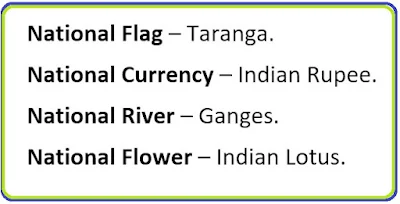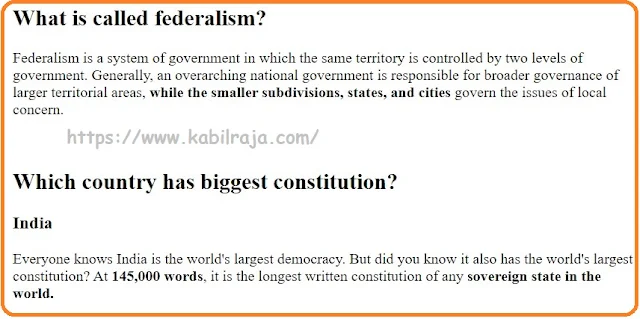Indian Constitution Article 2 – Admission and establishment of the new state
Which article is related to establishment of new territory?
The correct answer is Article 2. Being a sovereign state, India like other sovereign states has the inherent power to acquire the new territories. This implies that whenever new territory is acquired (by war, international agreements, etc) there is no need to make a law.
What is the process to create a new state?
New States may be admitted by the Congress into this Union; but no new State shall be formed or erected within the Jurisdiction of any other State; nor any State be formed by the Junction of two or more States, or Parts of States, without the Consent of the Legislatures
Which constitutional article provides for the formation of a new state?
Article 3 of
Article 3 of Indian Constitution addresses the topic of Formation of new States and alteration of areas, boundaries or names of existing States.
What is the difference between Article 2 and Article 3 of the Constitution?
Comparing both these provisions makes it quite evident that Article 2 deals with establishing or admission of a new state from outside the Indian Territory, however, Article 3 provides the power to create a new state from the existing states.
What does Article Two of the Constitution say?
Article Two vests the power of the executive branch in the office of the president of the United States, lays out the procedures for electing and removing the president, and establishes the president's powers and responsibilities.
Who can create a new State in India?
The constitutional power to create new states and union territories in India is solely reserved to the Parliament of India. Parliament can do so by announcing new states/union territories, separating territory from an existing state or merging two or more states/union territories or parts of them.
What is the process for DC to become a state?
Statehood will be achieved by the House and Senate passing and the President signing legislation admitting the new state. Statehood legislation, which requires a simple majority vote and cannot be repealed, is the way that every state, except for the original 13, became part of the United States.
What is the process for DC to become a state?
Statehood will be achieved by the House and Senate passing and the President signing legislation admitting the new state. Statehood legislation, which requires a simple majority vote and cannot be repealed, is the way that every state, except for the original 13, became part of the United States.
What steps are involved in admitting a new territory to the Union?
ask congress for admission.
congress passes an enabling act.
a territorial convention prepares the constitution; then put to a popular vote.
congress passes an act of admission.
president signs.
What does a territory need to become a state?
The U.S. Congress—both House and Senate—pass, by a simple majority vote, a joint resolution accepting the territory as a state. The President of the United States signs the joint resolution and the territory is acknowledged as a U.S. state.
When a Bill is introduced in the Parliament for the admission or establishment of new State that is not part of the Union of India it has to be passed by?
Article 2 of the Indian Constitution relates to admission or establishment of new States which are not part of the Union of India. b. Article 3 of the Indian Constitution provides for the formation of or changes in the existing States including Union territories.
Does creation of new State require constitutional amendment?
Creation of a new State requires a majority for Constitutional Amendment.
Under which article of the Constitution of India Parliament main admit a new State in the Indian Union?
Article- 3:
It states that the Parliament may by law form a new State by separation of a territory from any State or by uniting two or more States completely or in parts or by uniting any territory to a part of any State. It deals with the following: Formation of new States. Alteration of areas of States.
How a new state is formed Upsc?
Presidential reference is sent to State Assembly. After presidential reference, a resolution is tabled and passed in Assembly. Assembly has to pass a Bill creating the new State/States. A separate Bill has to be ratified by Parliament.
When was Article 2 of Indian Constitution used?
Parliament may, from time to time, by law admit into the Union, or establish, new States on such terms and conditions as it thinks fit. Draft Article 2 (Article 2) was debated on 5th November 1948 and 17th November 1948. It empowered the Parliament to make laws to admit or establish states to the Union.
What is the meaning of Article 2 Section 25?
The Constitution, Article 2, Section 25 reads, "The State shall ensure the autonomy of. local governments.
What requirements does Article II of the Constitution establish for becoming president of the United States?
The candidate must be at least 35 years old, a natural-born US citizen, and a US resident for 14 years.
What does Article 2 Section 2 Clause 1 of the Constitution mean?
The President shall be Commander in Chief of the Army and Navy of the United States, and of the Militia of the several States, when called into the actual Service of the United States; he may require the Opinion, in writing, of the principal Officer in each of the executive Departments
Can a new state be formed with the boundaries of an existing state?
Congress can admit new states into the Union, but a single state cannot create a new state within its boundaries. For example, the state of New York cannot make New York City a separate state.
Who permits the formation of new state in Union of India?
Parliament
One of special features of the Union of India is that the union is indestructible but the power conferred on Parliament includes the power to form a new state or union territory by uniting a part of any State or Union territory to other State or Union territory.
Which part of the Constitution must be amended to form new states in India?
The Fifth Amendment of the Constitution of India, officially known as The Constitution (Fifth Amendment) Act, 1955, empowered the President to prescribe a time limit for a State Legislature to convey its views on proposed Central laws relating to the formation of new States and alteration of areas, boundaries or names
Which article is related to the establishment of new territory?
The correct answer is Article 2. Being a sovereign state, India like other sovereign states has the inherent power to acquire the new territories. This implies that whenever new territory is acquired (by war, international agreements, etc) there is no need to make a law.
Which of the following in India is empowered to admit into the Union or establish new states?
Parliament
Parliament may, from time to time, by law admit into the Union, or establish, new States on such terms and conditions as it thinks fit. Draft Article 2 (Article 2) was debated on 5th November 1948 and 17th November 1948. It empowered the Parliament to make laws to admit or establish states to the Union.
Can a new state be created?
New States may be admitted by the Congress into this Union; but no new State shall be formed or erected within the Jurisdiction of any other State; nor any State be formed by the Junction of two or more States, or Parts of States, without the Consent of the Legislatures of the States concerned as well
What part of the Constitution talks about new states?
Article 3 of Indian Constitution
Article 3 of Indian Constitution addresses the topic of Formation of new States and alteration of areas, boundaries or names of existing States. The Constitution of India is the supreme law of our country and hence every law enacted by the government of India must conform to it.
How a new state is formed in India?
The constitutional power to create new states and union territories in India is solely reserved to the Parliament of India. Parliament can do so by announcing new states/union territories, separating territory from an existing state or merging two or more states/union territories or parts of them.
When the name of the state is changed or a new state is created the Constitution of India is required to be amended by Parliament by a?
Article 368 clearly states that if any change is to be made under the 7th schedule, then it has to be adopted by a special majority. Both houses of Parliament have to pass the Bill with a two-thirds majority.
When a bill is introduced in the Parliament for the admission or establishment of new state that is not part of the Union of India it has to be passed by?
Article 2 of the Indian Constitution relates to admission or establishment of new States which are not part of the Union of India. b. Article 3 of the Indian Constitution provides for the formation of or changes in the existing States including Union territories.
What is Article Two in the Constitution?
Article Two vests the power of the executive branch in the office of the president of the United States, lays out the procedures for electing and removing the president, and establishes the president's powers and responsibilities.
What is the meaning of Article 2 Section 15?
The Constitution, Article 2, Section 15 provides: "The State shall protect and promote the right to health of the people and instill health cO,nsciousness among them."
What does Article 2 of the Constitution say about the Electoral College?
Each State shall appoint, in such Manner as the Legislature thereof may direct, a Number of Electors, equal to the whole Number of Senators and Representatives to which the State may be entitled in the Congress: but no Senator or Representative, or Person holding an Office of Trust or Profit under the United States
What does Article 2 Section 2 of the Constitution mean?
The Constitution provides, in the second paragraph of Article II, Section 2, that “the President shall have Power, by and with the Advice and Consent of the Senate to make Treaties, provided two thirds of the Senators present concur.” Thus, treaty making is a power shared between the President and the Senate.
What was the purpose of Article I Section 2?
Article I, Section 2 made the qualifications for voting in U.S. House elections the same as those for voting in the larger branch of the state legislature. That effectively excluded women, as well as many free African Americans and Native Americans.
What are the two exceptions to the addition of new states?
The Meaning
In addition, two states, or parts of states (i.e. Oregon and Idaho or Wilmington, Delaware, and Philadelphia, Pennsylvania) cannot become states without the consent of the various state legislatures and Congress.










